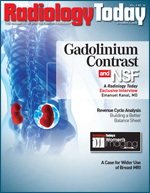
October 6, 2008
Mammography Film Digitization
By Kathy Schilling, MD
Radiology Today
Vol. 9 No. 20 P. 6
I recently faced a challenge that was having an impact on patient satisfaction: film retrieval. We perform nearly 60,000 procedures per year with patient jackets off site.
At The Center for Breast Care at the Women’s Center in Boca Raton, Fla., our staff are focused on the patient experience. We felt that our inability to always put our hands on patient films impacted our ability to provide the best experience for our patients, so we knew we needed to make a change. Breast center director Larraine Chrystal, MS, ARNP, and I also wanted to reduce staff inefficiencies, improve radiologist interpretation times, and lower the costs involved with storing, retrieving, and printing films.
It didn’t take us long to champion a plan that would help the center devise a better system for taking, storing, and accurately tracking mammography films: digitizing all of our outside and prior films. Having already replaced 11 analog mammography systems with seven digital acquisition systems, we were already well on our way.
Making the Transition
We knew that if we were going to meet our goals and gain internal support, we had to make sure that the digitization of prior films met the needs of the center’s key stakeholders. It was a big undertaking, but we did it as a team. We addressed concerns at the institutional level, making sure to comply with all legal requirements, establishing policies and procedures, creating release forms and tracking mechanisms, and educating the staff about correct procedures.
Each stakeholder had different pressing concerns about digitization. The IT department was seeking a solution that would seamlessly connect the center’s McKesson PACS system without exceeding storage availability. The radiologists wanted a quality system that would allow them to interpret digitized films accurately and efficiently for comparison with new digital studies. The technologists and support staff needed an easy-to-use system with support for implementation.
We were careful to put together policies and procedures that made sense for our facility, and we also created a system of checks and balances to keep us on the right track. Through this consensus approach, the center methodically moved forward with establishing a system to support digitization of prior film and started implementation in September 2007.
Locating the Right Product
In late 2006, we began searching for an appropriate system specific to mammography. We looked at every product available because we wanted to make sure that we found what we needed in terms of good image quality, ease of use, and connectivity. At RSNA 2006, we discovered iCAD’s TotalLook, which we thought may have all the right pieces to integrate it into our workflow.
Our organization ultimately chose the TotalLook system because the mammography-specific technology converts prior mammography films to digital images for comparative review on a single review workstation. A few of our radiologists who had worked with digitization elsewhere strongly supported our choice because they were confident it would help meet the different needs of the center’s users and improve the patient experience.
The PACS administrator is satisfied with TotalLook’s integration with the McKesson PACS and its easy archiving, storage, and retrieval capabilities. The radiologists are satisfied with TotalLook’s image quality and ease in comparing prior studies to the new digital studies as part of their interpretation. The technologists and support staff smoothly transitioned to the new system after receiving customized training from iCAD experts, who ensured the techs knew how to use the system. And in June, we upgraded our TotalLook systems to iCAD’s newest digitizing solution, TotalLook MammoAdvantage.
Given the up-front preparation and ongoing coordination in the center, the radiologists are able to read the images more efficiently, an estimated 10% to 20% faster.
With the system in place, when a new patient arrives for a mammogram at The Center for Breast Care, her analog films are digitized and returned immediately. Chrystal predicts that by November, 50% of our patients with prior film studies will be fully digitized in our system. And in the coming year, she is aiming for the full digitization of 80% of patients with prior film studies. The remaining 20% would consist of patients who didn’t come back or are new to our center.
We project significant cost savings over a three-year period. Because of improved efficiency, we project eliminating our overtime expenses. Instead of film retrieval and film-finding missions, employees are spending time attending to patients and working in other ways to improve the patient experience. Soon, we will be filmless, which will help us provide our patients with an even better experience.
— Kathy Schilling, MD, is the medical director of breast imaging and intervention at The Center for Breast Care at the Women’s Center in Boca Raton, Fla.
Snapshot … The Center for Breast Care at the Women’s Center
Affiliation: Boca Raton Community Hospital (400 beds)
First Opened: 1990
Procedures/Year: 60,000 (includes two satellite screening facilities)
Patients/Day: 180
Services
• Digital mammography
• Breast ultrasound
• Breast MRI
• MRI biopsies
• High-risk screening
• Positron emission mammography
• Bone densitometry
• Mobile screening van
• Research, teaching, and training
Staff (55 Employees)
• Nurse practitioners and navigators
• Eight dedicated breast imagers
• Support staff
Filmless Process Timeline
• 2004 — Converted 11 analog mammography systems to four digital mammography systems with computer-aided detection.
• 2007 — Began digitization of prior films with four iCAD TotalLook systems.
• 2008 — Upgraded to TotalLook MammoAdvantage.

